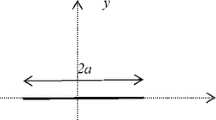Abstract
The general solution of an arbitrarily oriented sub-interface Zener–Stroh crack is derived with the aid of distributed dislocation methods. The crack problem is formulated as a set of singular integral equations and solved numerically so that the stress intensity factor can be evaluated for any orientation angle. To make the facture analysis more accurate, the plastic zone size (PZS) and the crack tip opening displacement (CTOD) are examined by the generalized Irwin model. The plastic zone area is assumed to follow the von Mises yielding criterion and can be related to the stress intensity factors at the crack tips. Numerical examples are given to demonstrate the influence of various parameters, such as material properties, crack–interface distance and loading ratios, on the normalized PZS and CTOD for vertical and parallel crack cases. It is found that the Zener–Stroh crack becomes easier to propagate when it is located in the “softer” phase of the bi-material structure and parallel to the material interface. If the crack is perpendicular to the interface, it would be much easier for the crack to propagate into the “softer” side of the structure.
Similar content being viewed by others
References
Hutchinson J.W., Mear M., Rice J.R.: Crack paralleling an interface between dissimilar materials. J. Appl. Mech. 54, 828–832 (1987)
Dundurs, J.: Elastic interaction of dislocations with inhomogeneities. Math. Theory Dislocations. In: Mura, T. (ed.) ASME, pp. 70–115, New York (1969)
Lu H., Lardner T.J.: Mechanics of subinterface cracks in layered material. Int. J. Solids Struct. 29, 669–688 (1992). doi:10.1016/0020-7683(92)90120-i
Thouless M.D., Evans A.G., Ashby M.F., Hutchinson J.W.: The edge cracking and spalling of brittle plates. Acta Metall. 35, 1333–1341 (1987). doi:10.1016/0001-6160(87)90015-0
Suo Z., Hutchinson J.W.: Steady-state cracking in brittle substrates beneath adherent films. Int. J. Solids Struct. 25, 1337–1353 (1989). doi:10.1016/0020-7683(89)90096-6
Borliang C., Lardner T.J.: Two-dimensional cracks at an angle to an interface. Int. J. Solids Struct. 30, 1725–1735 (1993). doi:10.1016/0020-7683(93)90229-Z
Fett T., Munz D., Tilscher M.: Weight functions for sub-interface cracks. Int. J. Solids Struct. 34, 393–400 (1997). doi:10.1016/s0020-7683(96)00010-8
Xiao Z.M., Fan H.: On the contact zone and stress singularities of a subinterface crack. Eng. Fract. Mech. 68, 77–88 (2001). doi:10.1016/s0013-7944(00)00087-4
Huang G.-Y., Wang Y.-S., Gross D.: Fracture analysis of functionally graded coatings: antiplane deformation. Eur. J. Mech. - A/Solids 21, 391–400 (2002). doi:10.1016/S0997-7538(02)01223-8
Beom H.G., Jeong K.M., Kim Y.H.: Intensity factors for subinterface cracks in dissimilar anisotropic piezoelectric media. Arch. Appl. Mech. 73, 184–198 (2003). doi:10.1007/s00419-003-0280-y
Tilbrook M.T., Rozenburg K., Steffler E.D., Rutgers L., Hoffman M.: Crack propagation paths in layered, graded composites. Compos. Part B: Eng. 37, 490–498 (2006). doi:10.1016/j.compositesb.2006.02.012
Yang P.-S., Liou J., Sung J.-C.: Subinterface crack in an anisotropic piezoelectric bimaterial. Int. J. Solids Struct. 45, 4990–5014 (2008)
Zhou K., Wu M.S.: Elastic fields due to an edge dislocation in an isotropic film-substrate by the image method. Acta Mech. 211, 271–292 (2010)
Thouless M., Li Z., Douville N., Takayama S.: Periodic cracking of films supported on compliant substrates. J. Mech. Phys. Solids 59, 1927–1937 (2011)
Sharma K., Bui T., Zhang C., Bhargava R.: Analysis of a subinterface crack in piezoelectric bimaterials with the extended finite element method. Eng. Fract. Mech. 104, 114–139 (2013)
Zhou K., Wei R.: Modeling cracks and inclusions near surfaces under contact loading. Int. J. Mech. Sci. 83, 163–171 (2014)
Zener, C.: The micro-mechanism of Fracture. Fracturing of Metals, American Society of Metals, pp. 3–31, Cleveland (1948)
Weertman J.: Zener–Stroh crack, Zener–Hollomon parameter, and other topics. J. Appl. Phys. 60, 1877–1887 (1986). doi:10.1063/1.337236
Fan H., Sun Y.M., Xiao Z.M.: Contact zone in an interfacial Zener–Stroh crack. Mech. Mater. 30, 151–159 (1998). doi:10.1016/s0167-6636(98)00044-1
Xiao Z.M., Chen B.J.: Stress analysis for a Zener–Stroh crack interacting with a coated inclusion. Int. J. Solids Struct. 38, 5007–5018 (2001). doi:10.1016/s0020-7683(00)00335-8
Xiao Z.M., Fan H., Sun Y.M.: On the contact zone of a subinterfacial Zener–Stroh crack. Acta Mech. 142, 133–148 (2000). doi:10.1007/bf01190015
Fan, M., Yi, D.K., Xiao, Z.M.: An interfacial arc-shaped Zener–Stroh crack due to inclusion–matrix debonding in composites. Acta Mech. 1–10 (2013). doi: 10.1007/s00707-013-1000-5
Waszczak J.: Applicability of linear elastic fracture mechanics to 5.6-mil boron/6061 aluminum. J. Aircr. 13, 770–777 (1976)
Sun C., Prewo K.: The fracture toughness of boron aluminum composites. J. Compos. Mater. 11, 164–175 (1977)
Yi D., Xiao Z., Zhuang J., Sridhar I.: On the plastic zone size and crack tip opening displacement of a sub-interface crack in an infinite bi-material plate. Philos. Mag. 91, 3456–3472 (2011)
Hills, D.A.: Solution of crack problems: the distributed dislocation technique. In: Hills, D.A., et al. (eds.) Solid Mechanics and Its Applications, vol. 44. Kluwer, c1996 (1996)
Erdogan F., Gupta G.D.: On the numerical solution of singular integral equations. Q. Appl. Math. 29, 525–534 (1972)
Irwin, G.R.: Plastic zone near a crack and fracture toughness. IN: Paper Presented at the Sagamore Research Conference Proceedings
Anderson T.L.: Fracture Mechanics: Fundamentals and Applications. CRC Press, Boca Raton (2005)
Author information
Authors and Affiliations
Corresponding author
Rights and permissions
About this article
Cite this article
Fan, M., Yi, D.K. & Xiao, Z.M. Fracture behavior investigation on an arbitrarily oriented sub-interface Zener–Stroh crack. Acta Mech 226, 1591–1603 (2015). https://doi.org/10.1007/s00707-014-1271-5
Received:
Revised:
Published:
Issue Date:
DOI: https://doi.org/10.1007/s00707-014-1271-5



